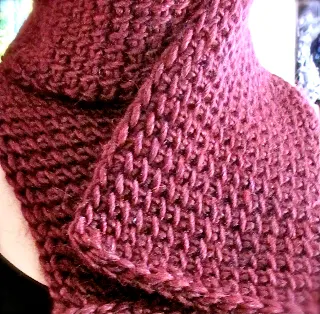The Half Double crochet stitch (HDC) is known as the Half Treble in the UK and Australia.
Do you love this stitch too? These four designs make good use of it:
 |
| L to R: Orbit Cowl, Half Double Handbag, Bling Bam Bangle for beginners, and Pallas. |
Come to think of it, so does the Buffalo Knot Belt!
2018 Update: New crocheters learn how to do the HDC stitch very early on, so it's really only a little bit tricky—in potentially two ways. The original blog post below is about identifying the true last stitch of an HDC row. Before you read it, check that you're doing the correct yarn over for it each time. You do a total of three yarn overs before you've completed each HDC. Some folks mix the yarn overs with "yarn unders".
Now, back to the show.
-:------------:-
The last HDC of a row can fool an unsuspecting crocheter.
When this happens, the stitch count of a row is accidentally increased or decreased, and uneven edges result.
 Here are four photos of HDC stitches. In the first one, how many more HDC do I need to complete the row?
Here are four photos of HDC stitches. In the first one, how many more HDC do I need to complete the row?a) Two
b) Three
c) Four
If you said two, you've been tricked by the last HDC stitch into thinking that it is the turning chain-2 that began that row. You would accidentally decrease a stitch. If you answered four, you're perceiving the turning chain-2 as being another HDC, and you would accidentally increase a stitch. We don't crochet into the turning chains of HDC rows (though there are occasional exceptions to this rule, and it will be explicitly stated in patterns). If you answered three, you're correct.

In the second photo I've completed all but the last remaining HDC of the same row as in the first photo. To make it more obvious where the last stitch will go, I poked the crochet hook into the space. Can you see the hole that remains from where the hook entered it? (compared to no hole in the first photo.) Anything after that hole is the turning chain-2, and we just ignore it.
Before I explain photos 3 & 4, I have a suggestion that might help. After all, no one will be looking over your shoulder and poking a crochet hook into the last real HDC so that you can tell for sure which is the last stitch.
The guideline I use for identifying the last HDC of a row is: the top two loops of the HDC are not found directly above the rest of the stitch. Instead,
- If you're crocheting in rows and turning to begin each new row, you're looking at the back of each hdc, and its two top loops are found just after the rest of the stitch.
- If you're not turning to begin each new row (such as when working in rounds), you're looking at the front of each hdc, and its two top loops are found just before the rest of the stitch.
 Photos 3 & 4 illustrate another tip that might help some crocheters. They are nearly identical to the first two photos. The third photo shows 3 HDC remaining. The fourth photo shows the last HDC after I've poked the crochet hook under the top two loops of it, so that you can see where I'm about to place my last HDC.
Photos 3 & 4 illustrate another tip that might help some crocheters. They are nearly identical to the first two photos. The third photo shows 3 HDC remaining. The fourth photo shows the last HDC after I've poked the crochet hook under the top two loops of it, so that you can see where I'm about to place my last HDC. The only difference between the second pair of photos and the first pair is the direction I turned my work to begin a new row after chaining 2. I'm crocheting right-handed, and in the first pair of photos I turned my work counterclockwise [a.k.a. anticlockwise] each time I began a new row. In the third and fourth photos, I turned my work clockwise each time I began a new row. (Someone crocheting left-handed would do the opposite.)
The only difference between the second pair of photos and the first pair is the direction I turned my work to begin a new row after chaining 2. I'm crocheting right-handed, and in the first pair of photos I turned my work counterclockwise [a.k.a. anticlockwise] each time I began a new row. In the third and fourth photos, I turned my work clockwise each time I began a new row. (Someone crocheting left-handed would do the opposite.)Controlling the way the turning chain-2 looks to you as you near the end of the row might help prevent you from being tricked into accidentally increasing or decreasing. To me, in the third photo I'm less likely to think the chain-2 is an HDC. Whereas, in the first photo, I'm tempted to wonder if I should crochet into the top two loops of the chain-2.
Happy crocheting, I hope this helps someone!
Here are two more ways the HDC is the star of the design: Mamruana and Rosebud Argyle.









